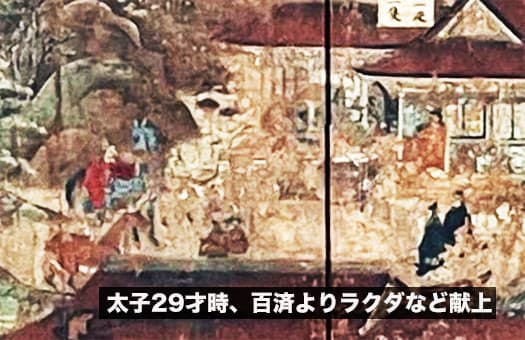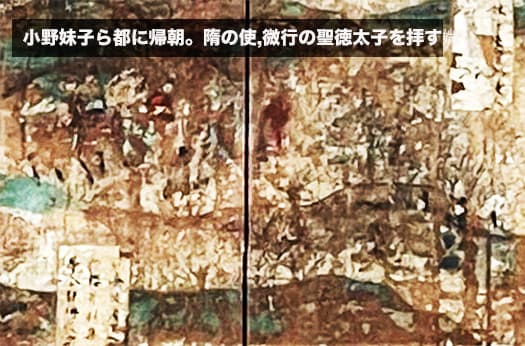


法隆寺宝物館「聖徳太子絵伝」記事、第11回目は小野妹子派遣などの東アジア世界との関わりについて。このシリーズの第一回はこちら→端正なモダニズム「法隆寺宝物館」探訪。
聖徳太子絵伝という壁面画についてはながく法隆寺の「秘伝」的なものとして所蔵され、戦後になって皇室に献上されたことから一般の目に触れることなく、一部の研究者のみが閲覧・見学できる存在だった。
なので全部で60にも及ぶという各シーンについて詳細な研究というのは行われなかった。公開されている研究論文でも絵画史としての分析が主で、多くの一般人の興味、歴史事実に対するその発生時に近い社会反応という分析興味があまり感じられない。
法隆寺宝物館デジタル展で、高精細な画像分析が公開されたことでたくさんの研究が今後、進展するように思う。わたしはその他凡百として、聖徳太子の事跡を表現するのにその時代が画家の手を通してどのように描かれたか、のほうに強く興味を持って見ています。
今回は聖徳太子の事跡のなかでもいちばん多い「外交」事跡。画面の剥落などでなかなか詳細ではないけれど、比較的に構図的にもわかりやすい2例。
百済国との関係というのがやはりもっとも多発する。日本という国家にとってこの朝鮮半島の地域国家はきわめて重要だったのだと思う。盛時はもちろん滅亡後の移民群も日本史に大きく変化要素を与えた。
上の画は「百済より駱駝など献上」とされたシーン。日本史上ではときどきゾウとかの国土に存在しない珍重動物が都の大路をデモンストレーションした記録がある。
動物園というものがなかった時代、庶民が世界の動物種を直接目に触れる機会というのはほとんどなかった。駱駝というのは西アジアの砂漠地帯を原産地域とする動物であり、東アジア一帯では棲息していない。その希少動物が隋では頻繁に隊商などを通して見られていただろう。それが極東の朝鮮半島・百済国を経て日本社会にもたらされたワケだ。
聖徳太子29才の時代の空気感がどうであったか想像力を刺激。シーンでは建物内部から庭先に駱駝が置かれている様子。太子は他でも富士山に黒駒にまたがって登頂したり、各地から馬を献上されたシーンもあるので、動物に関心が高かったように思う。
こういう希少動物との出会いなどが対外的な交流、外交の重要性を心理的にも強めたとも思える。仏教導入という基本政策の背景的心理要素を表しているのかも知れない。
そして次にあるのが、小野妹子の帰朝の様子。画面はそう鮮明ではないが左方に小野妹子一行があり、右手前方向に出迎え側が描写されている。聖徳太子はその出迎えの中に「微行」と書かれている。本来は権力者として帰朝した小野妹子を公式の場で「引見」するのだろうけれど、その外交交渉にあたっていかに心を砕いていたか、そのあまり、つい「出迎え」したと解すべきなのだろう。
随行した隋の国使はその様子に驚いて「拝す」ことになったものと思える。
「日出ずる国・日沈む国」外交書簡というギリギリ外交を展開して,その後の日本と中国国家の関係性の基底をつくった太子にして見ると、その任務を果たした小野妹子には強い信頼感・自らの外交選択の達成感をもったのだろう。時代の空気感を伝えてくれる。
English version⬇
[Prince Shotoku's Diplomacy in the East Asian World: The Gallery of Horyuji Treasures-11
Rare animals raised many citizens' awareness of the Japanese nation in the world. The thoughts of Prince Shotoku to Ono Imoko, the ambassador who created the basis of Japanese diplomacy. ...
The wall paintings of Shotoku Taishi were kept in the "secret" collection of Horyuji Temple for a long time, and were presented to the imperial family after the war, so they were never seen by the general public, and only a few researchers were able to view them.
Therefore, no detailed research was conducted on each of the 60 scenes in the paintings. Even the research papers that have been made available to the public are mainly analyses of the history of the paintings, which is of little interest to the general public, nor to the analysis of social reactions to historical facts close to the time of their occurrence.
The digital exhibition at the Gallery of Horyuji Treasures has made high-resolution image analysis available to the public, and I believe this will lead to more research in the future. I am more interested in how the period was depicted through the hands of the artist in order to express the traces of Shotoku Taishi.
In this exhibition, we will focus on "diplomacy," the most common of Shotoku Taishi's events. Although the details are not so detailed due to the loss of images, the two examples are relatively easy to understand in terms of composition.
The relationship with the Baekje Kingdom is the most frequent. I believe that this regional state on the Korean peninsula was extremely important to the Japanese nation. The immigrant groups that came to Japan not only during the period of its prosperity, but also after its destruction, greatly changed the course of Japanese history.
The above picture shows the scene where "a camel and other animals were presented from Baekje. In Japanese history, there are records of demonstrations of elephants and other rare animals that did not exist in Japan.
In the days when there were no zoos, common people rarely had the opportunity to see the world's animal species in person. The camel is an animal native to the deserts of Western Asia and does not live anywhere in East Asia. In the Sui Dynasty, this rare animal would have been frequently seen by traders. This is why they were brought to Japanese society via the Korean Peninsula and Baekje Province in the Far East.
The film stimulates the imagination of what the atmosphere was like in the age of Prince Shotoku, who was 29 years old. In the scene, a camel is placed in the garden from inside the building. In other scenes, Prince Shotoku climbed Mt. Fuji astride a kurokoma, and horses were offered to him from all over Japan.
It seems that encounters with rare animals like these may have psychologically strengthened the importance of external exchanges and diplomacy. This may represent a background psychological element of the basic policy of introducing Buddhism.
And next is the scene of Ono Imoko's return to Japan. Although the picture is not so clear, the group of Ono-no-Imoko is on the left, and the welcoming party is depicted in the right foreground. Prince Shotoku is described as a "slight movement" in the welcoming group. Although Prince Shotoku would normally have "met" Ono-no-Imoko on her return from the Sui Dynasty as a powerful person in an official capacity, he was so devoted to the diplomatic negotiations that he should be understood to have "greeted" her in a rather "slight gesture.
The Sui Dynasty envoys who accompanied him were surprised at the situation and decided to "pay their respects" to him.
The Taishi, who developed the "Land of the Rising Sun, Land of the Setting Sun" diplomatic letter, a last-minute diplomacy that laid the foundation for the subsequent relationship between Japan and China, must have felt a strong sense of trust and accomplishment in Ono-no-Imoko, who fulfilled her mission and made her own diplomatic choices. This letter conveys the atmosphere of the times.



















